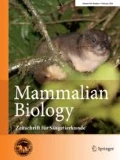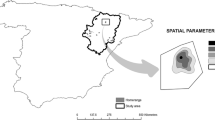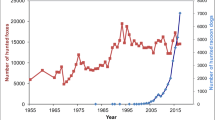Abstract
We studied the ranging patterns of 10 elephants in and around the Yala protected area complex, southern Sri Lanka, using VHF radio telemetry. All tracked elephants displayed similar ranging patterns. The observed home ranges were small (mean = 115.2±64.0 km2) relative to reported home ranges in India, possibly in response to high habitat productivity and abundant perennial water sources. Elephants showed high fidelity to their ranges. Home ranges had relatively large core areas, suggesting intensive use of habitat. No geographically distinct seasonal ranges or migratory behavior was observed. Home range overlap was high, and territoriality was absent. Male musth ranges were considerably larger than non-musth ranges and may signify mate searching. Most elephants ranged both in and outside protected areas, suggesting that resources outside protected areas were important for their survival. Thus, translocating and restricting elephants to protected areas will be detrimental to their survival, as it limits resource access. The ranging patterns of Asian elephants suggest that conservation of the species requires their management both in and outside protected areas.
Zusammenfassung
Mittels VHF Telemetrie untersuchten wir die Streifgebiete von 10 Elefanten in und um den Yala Nationalpark im Süden Sri Lankas. Alle besenderten Elefanten zeigten ähnliche Bewegungsmuster. Im Vergleich zu Indien waren die beobachteten Reviere in Sri Lanka relativ klein (115.2±64.0 km2). Dies ist vermutlich eine Folge der hohen Habitatsproduktivität und der ganzjährigen Verfügbarkeit von Wasser in Sri Lanka. Die Elefanten zeigten sich ihrem Revier sehr treu. Die Streifgebiete hatten relativ grosse Aktivitätszentren, was auf eine intensive Nutzung des Habitats hindeutet. Es wurden weder geografisch unterschiedliche saisonale Reviere noch Migrationen beobachtet. Die Überlappung der Reviere war gross, und Territorialität war nicht vorhanden. Die Steifgebiete der Männchen in Musth waren deutlich grösser als die Gebiete ausserhalb der Musth. Die Ursache dafür könnte die Suche nach einem paarungsbereiten Weibchen sein. Die meisten Elefanten hielten sich sowohl innerhalb als auch ausserhalb des Yala Nationalparks auf, was darauf hinweist, dass die Gebiete ausserhalb des Parks für ihr Überleben wichtig sind. Demzufolge gefährden Umsiedlungen und Restriktion auf die Naturschutzgebiete das Überleben der Elefanten, da der Zugang zu den Ressourcen ausserhalb des Parks verwehrt wird. Die Bewegungsmuster der Elefanten deuten darauf hin, dass zur Arterhaltung Gebiete innerhalb und ausserhalb der Nationalparks berücksichtigt werden müssen.
Similar content being viewed by others
References
Barnes, R.F.W., 1982. Mate searching behaviour of elephant bulls in a semi-arid environment. Anim. Behav. 30, 1217–1223.
Baskaran, N., Desai, A.A., 1996. Ranging behavior of the Asian elephant (Elephas maximus) in the Nilgiri biosphere reserve, South India. Gajah 15, 41–57.
Baskaran, N., Balasubramanian, M., Swaminathan, S., Desai, A.J., 1993. Home range of elephants in the Nilgiri Biosphere Reserve, South India. In: Daniel, J.C., Datye, H. (Eds.), A Week With Elephants. Proceedings of the International Seminar on Asian Elephants. Natural History Society, Oxford University Press, Bombay, pp. 298–313.
Belcher, C.A., Darrant, J.P., 2004. Home range and spatial organization of the marsupial carnivore, Dasyurus maculatus maculatus (Marsupialia: Dasyuridae) in south-eastern Australia. J. Zool. 262, 271–280.
Burt, W.H., 1943. Territoriality and home range concepts as applied to mammals. J. Mammal. 24, 346–352.
Carpenter, F.L., MacMillen, R.E., 1976. Threshold model of feeding territoriality and test with a Hawaiian honeycreeper. Science 194, 639–642.
Clutton-Brock, T.H., Harvey, P.H., 1978. Mammals, resources and reproductive strategies. Nature 273, 191–195.
Clutton-Brock, T.H., Harvey, P.H., Rudder, B., 1977. Sexual dimorphism, socionomic sex ratio and body weight in primates. Nature 269, 797–800.
Dahle, B., Swenson, J.E., 2003. Home ranges in adult Scandinavian brown bears (Ursus arctos): effect of mass, sex, reproductive category, population density and habitat type. J. Zool. 260, 329–335.
Datye, H.S., Bhagwat, A.M., 1995. Home range of elephants in fragmented habitats of central India. J. Bombay Nat. Hist. Soc. 92, 1–10.
Desai, A.A., 1991. The home range of elephants and its implications for management of Mudumalai wildlife sanctuary, Tamil Nadu. J. Bombay Nat. Hist. Soc. 88, 145–156.
De Villiers, P.A., Kok, O.B., 1997. Home range, association and related aspects of elephants in the eastern Transvaal Lowveld. Afr. J. Ecol. 35, 224–236.
Douglas-Hamilton, I., 1973. On the ecology and behaviour of the lake Manyara elephants. E. Afr. Wildl. J. 11, 401–403.
Dunham, K.M., 1986. Movements of elephant cows in the unflooded middle Zambezi valley, Zimbabwe. Afr. J. Ecol. 24, 287–291.
Easa, P.S., 1988. Movement pattern of Asiatic elephant, Elephas maximus in Parambikulam Wildlife Sanctuary, Kerala. Kerala Forest Research Institute Research Report 54 (Summary). Kerala Forest Research Institute, India.
Eisenberg, J.F., Lockhart, M., 1972. An ecological reconnaissance of Wilpattu national park, Ceylon. Smithsonian Contributions to Zoology No. 101.
Eisenberg, J.F., McKay, G.M., Jainudeen, M.R., 1971. Reproductive behaviour of the Asiatic elephant (Elephas maximus L.). Behaviour 38, 193–225.
Fernando, P., 1997. Keeping jumbo afloat: is translocation an answer to the human-elephant conflict? Sri Lanka Nature 1, 4–12.
Fernando, P., 2000. Elephants in Sri Lanka: past, present, and futur. Loris 22, 38–44.
Fernando, P., Lande, R., 2000. Molecular genetic and behavioral analyses of social organization in the Asian elephant. Behav. Ecol. Sociobiol. 48, 84–91.
Fernando, P., Wickramanayake, E., Weerakoon, D., Jaya-singhe, L.K.A., Gunawardene, M., Janaka, H.K., 2005. Perceptions and patterns in human-elephant conflict in old and new settlements in Sri Lanka: insights for mitigation and management. Biodiv. Conserv. 14, 2465–2481.
Fisher, D.O., Owens, I.P.F., 2000. Female home range size and the evolution of social organization in macropod marsupials. J. Anim. Ecol. 69, 1083–1098.
Galanti, V., Preatoni, D., Martinoli, A., Wauters, L.A., Tosi, G., 2006. Space and habitat use of the African elephant in the Tarangire-Manyara ecosystem, Tanzania: implications for conservation. Mamm. Biol. 71, 99–114.
Ganswindt, A., Rasmussen, H.B., Heistermann, M., Hodges, J.K., 2005. The sexually active states of free-ranging male African elephants (Loxodonta africana): defining musth and non-musth using endocrinology, physical signals, and behavior. Horm. Behav. 47, 83–91.
Grainger, M., van Aarde, R., Whyte, I., 2005. Landscape heterogeneity and the use of space by elephants in the Kruger national park, South Africa. Afr. J. Ecol. 43, 369–375.
Harestad, A.S., Bunnell, F.L., 1979. Home range and body weight - a re-evaluation. Ecology 60, 389–404.
Ishwaran, N., 1983. Elephant and woody-plant relationships in Gal Oya, Sri Lanka. Biol. Conserv. 26, 255–270.
Jayewardene, J., 1994. The Elephant in Sri Lanka. The Wildlife Heritage Trust of Sri Lanka, Colombo.
Joshua, J., Johnsingh, A.J.T., 1993. Ranging patterns of elephants in Rajaji National Park: implications for reserve design. In: Daniel, J.C., Datye, H. (Eds.), A Week with Elephants. Proceedings of the International Seminar on Asian Elephants. Bombay Natural History Society, Oxford University Press, Bombay, pp. 256–260.
Kie, J.G., Baldwin, J.A., Evans, C.J., 1996. CALHOME: a program for estimating animal home ranges. Wildl. Soc. Bull. 24, 342–344.
Laundre, J.W., Keller, B.L., 1984. Home range size of coyotes: a critical review. J. Wildl. Manage. 48, 127–139.
Leimgruber, P., Gagnon, J.B., Wemmer, C., Kelly, D.S., Songer, M.A., Selig, E.R., 2003. Fragmentation of Asia’s remaining wildlands: implications for Asian elephant conservation. Anim. Conserv. 6, 347–359.
Lindeque, M., Lindeque, P.M., 1991. Satellite tracking of elephants in northwestern Namibia. Afr. J. Ecol. 29, 196–206.
Lindstedt, S.L., Miller, B.J., Buskirk, S.W., 1986. Home range, time, and body size in mammals. Ecology 67, 413–418.
McKay, G.M., 1973. Behavior and ecology of the Asiatic elephant in southeastern Ceylon. Smithsonian Contributions to Zoology No. 125.
Mohr, C.O., 1947. Table of equivalent populations of North American mammals. Am. Midland Nat. 37, 223–249.
Moss, C.J., Poole, J.H., 1983. Relationships and social structure of African elephants. In: Hinde, R.A. (Ed.), Primate Social Relationships. Blackwell Science Publications, pp. 315–325.
Mueller-Dombois, D., 1972. Crown distortion and elephant distribution in the woody vegetations of Ruhuna national park, Ceylon. Ecology 53, 208–226.
Nagy, K.A., 1987. Field metabolic rate and food requirement scaling in mammals and birds. Ecol. Monogr. 57, 111–128.
Olivier, R., 1978. Distribution and status of the Asian elephant. Oryx 14, 379–424.
Poole, J.H., Moss, C.J., 1981. Musth in the African elephant. Nature 292, 830–831.
Powell, R.A., 2000. Animal home ranges and territories and home range estimators. In: Boitani, L., Fuller, T.K. (Eds.), Research Techniques in Animal Ecology. Columbia University Press, New York, pp. 65–110.
Rodgers, D.H., Elder, W.H., 1977. Movements of elephants in Luangwa valley Zambia. J. Wildl. Manage. 41, 56–62.
Rolando, A., 1998. Factors affecting movements and home ranges in the jay (Garrulus glandarius). J. Zool. 246, 249–257.
Samuel, M.D., Pierce, D.J., Garton, E.O., 1985. Identifying areas of concentrated use within the home range. J. Anim. Ecol. 54, 711–719.
Sandeil, M., 1989. The mating tactics and spacing patterns of solitary carnivores. In: Gittleman, J.L. (Ed.), Carnivore Behaviour, Ecology and Evolution. Cornell University Press, Ithaca, pp. 164–182.
Santiapillai, C., Jackson, P., 1990. The Asian Elephant: An Action Plan for its Conservation. IUCN, Gland, Switzerland.
Steinheim, G., Wegge, P., Fjellstad, J.i., Jnawali, S.r., Weladjil, R.b., 2005. Dry season diets and habitat use of sympatric asian elephants (Elephas maximus) and greater one-horned rhinoceros (Rhinocerus unicornis) in Nepal. J. Zool. 265, 377–385.
Stokke, S., du Toit, J.T., 2002. Sexual segregation in habitat use by elephant in Chobe national park, Botswana. Afr. J. Ecol. 40, 360–371.
Stüwe, M., Abdul, J.B., Nor, B.M., Wemmer, C.M., 1998. Tracking the movements of translocated elephants in Malaysia using satellite telemetry. Oryx 32, 68–74.
Sukumar, R., 1989a. The Asian Elephant: Ecology and Management. Cambridge University Press, Cambridge.
Sukumar, R., 1989b. Ecology of the Asian elephant in southern India. I. Movement and habitat utilization patterns. J. Trop. Ecol. 5, 1–18.
Survey Department, 1988. National Atlas of Sri Lanka. Survey Department, Colombo.
Thouless, C.R., 1996. Home ranges and social organization of female elephants in northern Keny. Afr. J. Ecol. 34, 284–297.
Venkataraman, A.B., Saandeep, R., Baskaran, N., Roy, M., Madhivanan, A., Sukumar, R., 2005. Using satellite telemetry to mitigate elephant-human conflict: an experiment in northern West Bengal, India. Curr. Sci. 88, 1827–1831.
Viljoen, P.J., 1989. Spatial distribution and movements of elephants (Loxodonta africana) in the northern Namib desert region of the Kaokoveld, South West Africa/ Namibia. J. Zool. 219, 1–19.
Vincent, J.P., Bideau, E., Hewison, A.J.M., Angibault, J.M., 1995. The influence of increasing density on body weight, kid production, home range and winter grouping in roe deer (Capreolus capreolus). J. Zool. 236, 371–382.
White, G.C., Garrot, R.A., 1990. Analysis of Wildlife Radio-Tracking Data. Academic Press, San Diego, CA.
Author information
Authors and Affiliations
Corresponding author
Rights and permissions
About this article
Cite this article
Fernando, P., Wikramanayake, E.D., Janaka, H.K. et al. Ranging behavior of the Asian elephant in Sri Lanka. Mamm Biol 73, 2–13 (2008). https://doi.org/10.1016/j.mambio.2007.07.007
Received:
Accepted:
Published:
Issue Date:
DOI: https://doi.org/10.1016/j.mambio.2007.07.007




